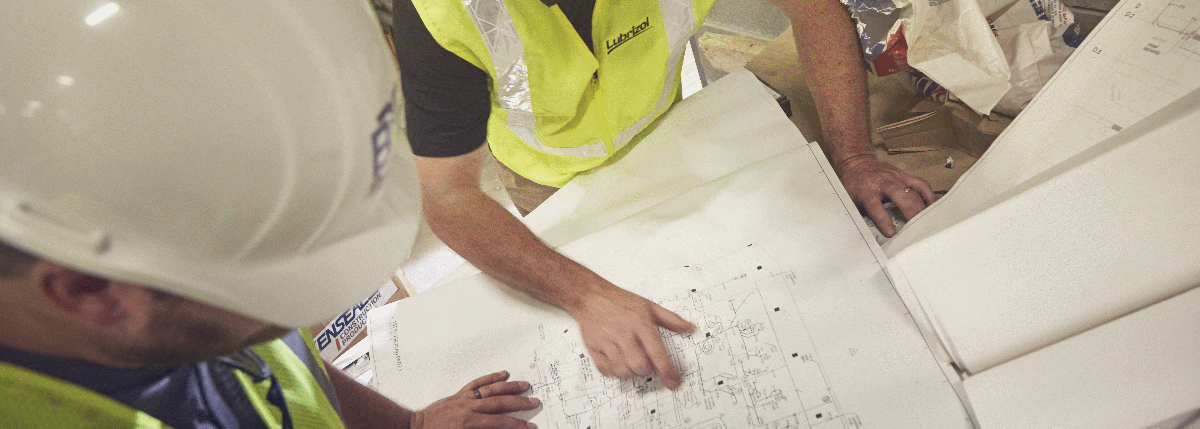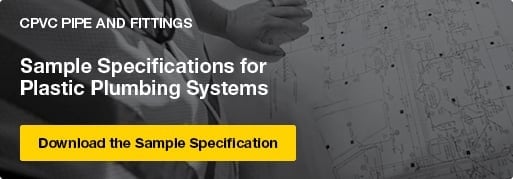
By: Jonathan Simon on July 13th, 2022
Engineering More Sustainable Plumbing Systems
Plumbing engineers are increasing their focus on sustainability due to both market demand and a personal commitment to support more sustainable homes and buildings. Improving plumbing system sustainability requires consideration of a range of factors, including material sustainability, use of designs that can minimize water waste, and the total environmental impact of a system.
Factors Affecting Plumbing Material Sustainability
The sustainability of a particular plumbing material, whether plastic like PEX and CPVC or metal like copper, is influenced by its embodied energy, longevity and recyclability.
- Embodied Energy: The energy needed for the manufacturing and transportation of a building material has become a key factor for builders and engineers seeking to optimize sustainability. CPVC has a clear advantage in terms of embodied energy as it requires less energy to manufacture and produces fewer greenhouse gases than PEX and copper. According to data in the NIST Building for Environmental and Economic Sustainability (BEES) database, PEX plumbing systems have approximately 7% more embodied energy than CPVC. Over the life of a small house, the BEES database shows that operating a CPVC plumbing system emits nearly 1 ton less carbon into the atmosphere than PEX, the equivalent of 105 gallons of gasoline.
- Longevity: The longer a product can perform in its intended environment, the less material is ultimately required to support the application. Both PEX and copper can be eroded by chlorine and other chemicals used to keep drinking water safe, potentially shortening their lifespan. CPVC is immune to chlorine degradation, allowing the material to achieve a long life even in aggressive water conditions.
- Recyclability: Like most metals, copper piping is easily recycled. CPVC can also be recycled at proper centers and the uses for recycled CPVC continue to expand. PEX is not recyclable and must be landfilled.
Summary of Plumbing Material Sustainability Attributes |
|||
| FlowGuard Gold® CPVC* | PEX | Copper | |
| Lowest embodied energy | ✓ | ||
| Immune from chlorine | ✓ | ||
| Recyclable | ✓ | ✓ | |
| Lowest thermal conductivity | ✓ | ||
| Has a lifecycle assessment | ✓ | ||
| NGBS-certified | ✓ | ||
Design Decisions that Impact Plumbing System Sustainability
Through properly designed hot water recirculating or manifold systems, plumbing engineers can reduce water waste in multi-story buildings. Material selection and how these systems are executed impact whether these strategies achieve their desired benefits.
- Hot water recirculating systems: These systems are required by International Energy Code for buildings three stories or higher, because they can reduce the amount of water that is flushed from pipes in hot water lines. However, they can also have unintended consequences depending on the material used. PEX manufacturers limit velocity in hot water recirculation systems to 2 feet per second to reduce the risk of chlorine degradation. That can impact flow rates across the system and may require upsizing the piping to compensate for the reduced velocities, negating the water-saving benefits of the recirculating system. Since CPVC is immune to chlorine, manufacturer-recommended velocities of 8-10 feet per second can be maintained in the hot water recirculating system, eliminating the need for upsizing. Thermal conductivity can also impact the sustainability of a hot water recirculating system as heat escaping from the pipes can force water heating systems to work harder even when the pipe is insulated. CPVC offers thermal conductivity roughly 3 times better than PEX and 1000 times better than copper.
- Manifold and mini-manifold systems: Remote or mini-manifolds can be an effective code-compliant workaround to a full hot water recirculating system, but too often get executed in a way that negates their benefits and increases project costs. PEX mini-manifolds are often located too far from the fixtures they support, requiring long branch lines that add to material costs without reducing water waste. CPVC manifolds, such as the FlowGuard MultiPort, actively encourage smart system design that minimizes the length of branch lines to help ensure system designs achieve the desired sustainability benefits. Home-run style systems are never environmentally friendly alternatives, as they can increase material use by a factor of 10 or more while also increasing water waste.
Tools for Evaluating Plumbing System Sustainability
There are multiple tools and resources engineers can use to streamline the process of selecting the most sustainable plumbing materials:
- Lifecycle assessments (LCAs): LCAs can be a valuable resource in selecting the most sustainable material. The LCA provides an objective, third-party and quantitative analysis of a system’s cradle-to-grave environmental impact, including raw materials, manufacturing, transportation and end-of-life. In addition, products that have an LCA contribute to LEED credits. LCAs have been performed on both FlowGuard Gold CPVC for copper-tube sizes 2” or smaller and Corzan CPVC for iron-pipe sizes larger than 2”.
- Certifications: Programs such as the Home Innovation Labs National Green Building Standard (NGBS) provide certifications that can be helpful in quickly identifying the most sustainable solutions on the market. FlowGuard Gold CPVC is the only NGBS certified residential plumbing system today. That means the use of FlowGuard Gold pipes and fittings has been independently verified to improve environmental impact measures by an average of 15% or greater and results in points awarded toward project certification under ICC-700 National Green Building Standard.
- NIST BEES: The final tool to consider is the Building for Environmental and Economic Sustainability (BEES) software provided by the National Institute of Standards and Technology (NIST). This software puts a powerful tool for selecting cost-effective, environmentally preferable building products at your fingertips. Using BEES to compare CPVC and PEX illustrates the many sustainability benefits of CPVC. In an ISO-compliant comparison of the two materials for a large home with a clustered use pattern and the same transportation distance, CPVC outperforms PEX in ten of 11 measured categories.
The Clear Choice for Sustainability
While there are multiple factors that must be considered when choosing the most sustainable plumbing material, the decision itself is simple. FlowGuard Gold CPVC has the lowest embodied carbon, effectively supports water-efficient recirculating and manifold systems, and is the only plumbing system that is NGBS certified and supported by a cradle-to-grave LCA. If you’re looking to maximize the sustainability of your designs, download our sample specifications for use as a guide on your next project.


